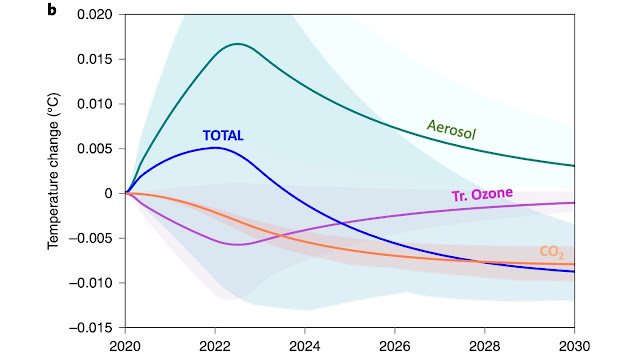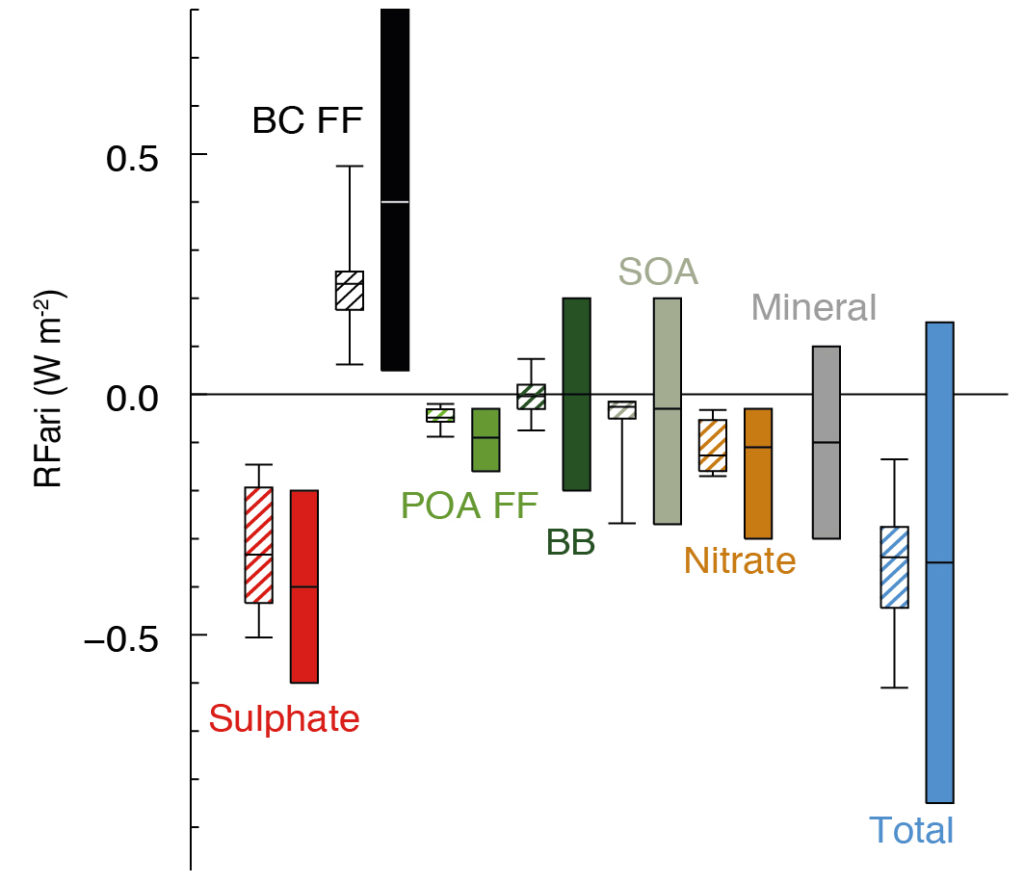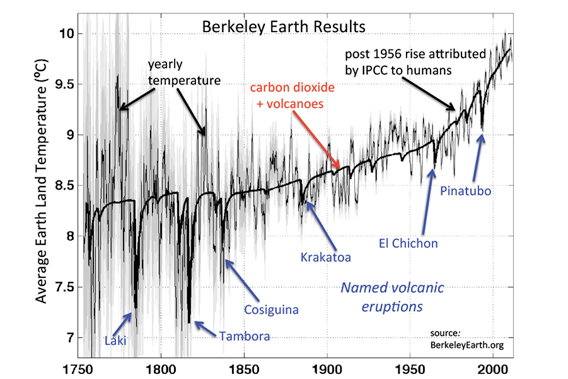Effects of COVID lockdowns on climate change
Simply put: Forster et al. (2020)
To answer this question, Forster et al. (2020) [Nature Climate Change]1 modelled the effect of these lockdowns on climate change. They developed a new method of estimating emissions changes during the lockdowns using global mobility data from Google and Apple. Combining these with existing estimates of emissions changes from major sectors - power, surface transport, residential, public and commercial, industry, national shipping, international shipping, national aviation and international aviation - they studied changes in ten species of green house gases (GHGs) and air pollutants over the period February - June 2020. Their analysis includes emission changes from 123 countries around the world, which together cover >99% of global fossil fuel CO2 emissions.
These emission changes were then converted to a temperature response. This temperature response was also extended into the future based on four future pathways, using the simple climate model FaIR v1.52. In particular, the "two-year blip pathway" represents a situation where partial lockdowns are in place for two years, but emissions recover to original values afterwards. Note that a fossil-fuelled recovery and green recovery (moderate green stimulus and strong green stimulus) are represented in three other pathways.
The results are striking - but not in the way we'd hope for. The researchers conclude that "the direct effect of the pandemic-driven response will be negligible, with a cooling of around 0.01 ± 0.005 ℃ by 2030". Note the "TOTAL" in the figure below - it first rises till about 2022 and then falls in the long-term, but both the rise and the fall are rather modest. This result is for the "two-year blip pathway" which leads to a CO2 concentration of about 510 ppm by the year 2050. For context, we're at about 410 ppm right now.
 | |
| Source: Forster et al. (2020), Fig. 4b What does this figure mean? | |
So hang on -- does this mean that the dramatic upheaval of all our lives , the locking up of entire countries and their vast populations, the temporary shutdown of industries, the empty streets and even the very clear skies -- were almost inconsequential in the face of climate change? While the blunt answer is yes, there is a lot to be learnt (and hence, gained) here.
(1) Aerosols: a Schrodinger's cat in the climate discussion
The role of aerosols in the context of air pollution is quite straightforward. However, it is not so easy to label them as 'culprits' in the context of climate change. The net effect of aerosols on the climate is highly variable and difficult to pin down. This is because aerosols have several different properties which may be contradictory in terms of their radiative forcing (effect on climate). Here is a figure from the IPCC's Fifth Assessment Report which shows a part of the radiative forcing by aerosols3. Different aerosol species are shown in bars of different colors, with the last one in blue showing the Total, which is negative. Thus, the net effect is a slight cooling, though there still exist large uncertainties.
 |
| Source: IPCC's AR5 What does this figure mean? |
The best example to understand this cooling effect is that of large volcanic eruptions. The injection of aerosols in the atmosphere cools the planet for a few years after the eruption. This happens because aerosols can scatter a part of the incoming solar radiation back into space.
 |
| Source: This Mongabay article that made me chuckle What does this figure mean? |
In the work by Forster et al., a reduction in NOx emissions (~30%) led to a short-term cooling but it was largely offset by a reduction in SO2 emissions (~20%) that led to a short-term warming.
(2) Aerosols: a Schrodinger's cat in any environmental discussion
So what do we choose in the larger picture - the potential "good" effect an aerosol can have as a cooling agent, or the bad effect it has as an air pollutant or in leading to acid rain? Despite its negative radiative forcing, no sensible climate scientist4 advocates for an increase in aerosol loadings in the atmosphere. Such considerations are especially critical in discussions about geoengineering. If you have the time, do read this article that explains just how complicated this situation is.
Forster et al. recommend that policies should be developed in a way so that concurrent warming and cooling effects are cancelled out. Policies aimed at reducing pollution from the transport sector could have a cooling effect through a reduction in NOx. On the other hand, policies aimed at reducing pollution from the power and industry sector could have a warming effect through a reduction in SO2. Thus, they recommend that policies be directed at all three sectors together.
A key point here is: reducing pollution may "harm" climate progress in the short term. And that's okay.
(3) Air pollution and climate change are two distinct problems
This brings to mind the idiom: One man's meat is another man's poison. What works for the air pollution crisis may not work for the climate crisis. We require different approaches, and hence different expertise, to solve these two crises. One size does not fit all.
This brings me to one of my current-favourite concepts: that of intellectual resolution. Simply put, we need public awareness for everyone to distinguish between air pollution and climate change. Without that, we may be left assuming that clearer skies warrant climate complacency. They don't.
 |
| Figure not to scale. Obviously. |
(4) The scale of the climate crisis: and the need to decarbonize structurally
The final and most important takeaway, in my opinion, is recognizing the amount of climate action that is required to truly solve the crisis. Forster et al. put it quite well:
"These results highlight that without underlying long-term system-wide decarbonization of economies, even massive shifts in behaviour, only lead to modest reductions in the rate of warming."
If we were to depend only on behavioural changes that were enforced during the lockdowns - reduced mobility, drastically less flying, working from home - and even add reduced industrial activity to this - we still would not make even a dent in the climate crisis. One report suggests that we would need a pandemic-sized carbon slowdown every year for the next 10 years to solve the climate crisis. I doubt even the most passionate and socially-involved climate scientists or activists would ever vote for that.
Truly solving the climate crisis requires us to change things from the foundation. As long as our societies are driven by climate-harming fossil fuels, personal sacrifices can not be the solution5. Green recoveries to the pandemic could lead to much better futures - possibly avoiding future warming of 0.3 ℃ by 2050. Governments must prioritize low-carbon energy options and energy efficiency. They should withdraw all support to unclean energy sources - support that currently places unclean energy sources at par with clean energy sources (which is not realistic or sustainable) and thus favours them inappropriately6. Lastly, the world urgently needs focus on global net-zero targets7.
---
P.S. I found an article Piers Forster wrote himself about this work. If you've made it this far, reading his article will improve your clarity. Much recommended: "Did the pandemic make a dent in climate change? A climate scientist answers"
---
If you like such posts, you may subscribe on this page.
---
More information:
1] This content has been made available to all by the published. I encourage you to check out figures 4 and 5.
2] Simple climate models do not incorporate all the complex climate processes that fully-coupled global climate models do. This can be understood as using a slightly blurred view of physical processes, that does not incorporate all known details. The "flaws" of simplification are balanced by some benefits such as computational ease. Such models run faster, and hence can be used to simulate many different scenarios of the future.
3] RFari = Radiative Forcing associated with Aerosol-Radiation interactions. The other component is RFaci = Radiative Forcing associated with Aerosol-Cloud interactions. Refer Fig. 7.3 of the AR5.
4] Okay, I admit: No climate scientist that *I know*.
5] Please, I do not mean to discourage individual efforts. I only ask that you place them properly in the larger picture. And if you can focus on only one - individual efforts or collective efforts that influence policies - definitely work on the latter. The rot is systemic, we can not clean it without changing the system.
6] The Indian Government still supports fossil fuels. We're often distracted from this issue by several (true) claims such as "India is moving its subsidies away from fossil fuels to renewables" and "Renewable energy subsidies have increased xyz amount". Despite all of this, India's subsidies to fossil fuels was 7 times its subsidies to renewables and electric vehicles in FY2019. Do read this LiveMint article or this IndiaSpend article on the CEEW report.
To add insult to injury, the Indian Government has decided to opt for a (deeply problematic) fossil-fuel based recovery to the pandemic. The virtue-signalling has obviously not stopped.
7] Note the use of the word "global". Net-zero need not be a national target for every country in the world.


Comments
Post a Comment